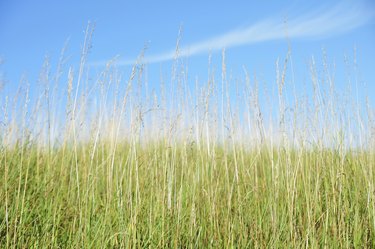Things You'll Need
Breaker bar
Socket
Wood block
Vice
Bastard mill file
Machine oil

Bush Hog sells mowers that range in size from large pull-behind tractor implement mowers to smaller lawn tractors useful for the average homeowner. Regardless of size, Bush Hog's mowers are rotary models that use a single blade spinning horizontally to cut through thin grass blades or tough brush. Frequent use -- as well as rocks and stumps -- dulls the blades, so they should be sharpened periodically to cut most effectively.
Step 1
Pull the spark plug wire from the spark plug to prevent any chance of the engine firing while you work. Unbolt the mower deck with a breaker bar and socket. Slide the deck out from under a Bush Hog lawn tractor to gain access to the blade. Flip the deck on its side, and chock the blade with a piece of wood between the blade end and deck to keep it from spinning. Unbolt the blade and slide it off the deck spindle. Pull-behind tractor implement mower blades are removed similarly, but the implement must be disconnected from the PTO shaft before you remove the blades. These large mower decks have two or three separate blades on separate spindles.
Video of the Day
Step 2
Place the blade in a vice with the beveled side facing toward you; tighten the vice to hold the blade in place while you work. Rotary cutting blades are straight, rectangular pieces of metal with a cutting edge along either end. The blade must be repositioned so you can sharpen the edge at the opposite end.
Step 3
Hold a 12- to 14-inch bastard mill file against the blade, starting at the end closest to the center where the blade bolts to the deck. Adjust the angle of the file to match the original beveled angle on the blade -- the angle at which the blade was sharpened at the factory. Most mower blades are sharpened at a 40-degree angle, but it's always best to follow the original bevel angle. This ensures the proper amount of sharpening and prevents grinding away too much of the metal.
Step 4
Push the file across the blade away from your body to grind the metal and sharpen the blade. Make repeated passes as you work your way to the end of the blade. Continue filing the blade until it's sharp, which takes roughly 50 passes with the file.
Step 5
Rub the file along the back side of the blade a few times to file off the metal burrs that develop as a byproduct of sharpening the angled edge. Reposition the mower blade and sharpen the second cutting edge at the opposite end.
Step 6
Hang the blade on a nail through the bolt hole at the center to check for balance. If one side is filed down more than the other, the heavier side tilts down instead of the blade balancing horizontally. Sharpen the heavier side more to balance the blade better.
Step 7
Rub machine oil or a similar oil along the bare metal where you sharpened the blades. Oil protects the exposed metal and prevents rust.
Step 8
Replace the mower blades on the mower deck. This is a good time to lubricate all the moving parts on the mower deck and perform any other mower maintenance.
Tip
At minimum, Bush Hog blades should be sharpened before your first use of the mower in spring. Sharpen the blades more frequently if you notice ragged tips when you cut grass. Sharp blades slice through grass easily, but dull blades tear the grass, leaving it open to disease.
Some mower owners prefer to skip the blade removal step and sharpen the blade while it's still attached to the mower deck, but Bush Hog recommends removing the blades for sharpening.
Warning
Angle grinders and bench grinders sharpen metal blade edges much faster than mill files, but with speed comes loss of precision. You risk grinding too much of the blade or grinding unevenly with mechanical grinding tools unless you are highly experienced in their operation.
Video of the Day
- The Family Handyman: Lawn Mower Blade Sharpening
- This Old House: How to Sharpen Lawn Mower Blades
- The Home Depot: Sharpening a Mower Blade
- Grounds Maintenance Magazine: How to: Sharpen Rotary Mower Blades
- Bush Hog: Bush Hog Rear Discharge Finishing Mower Operator's Manual
- Owner IQ: Bush Hog Tough Home Series Zero Turn Mowers